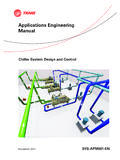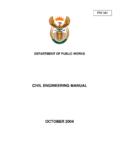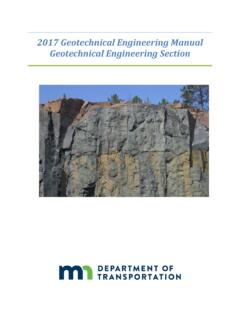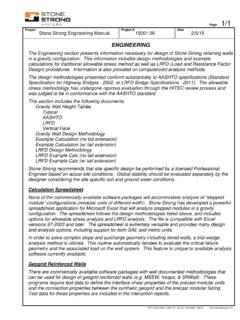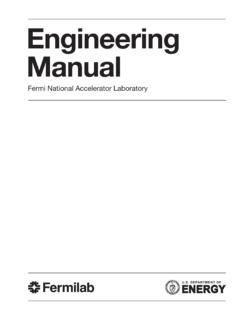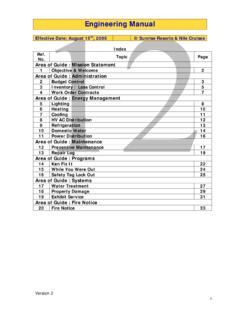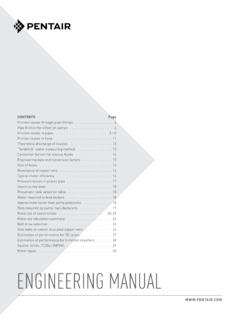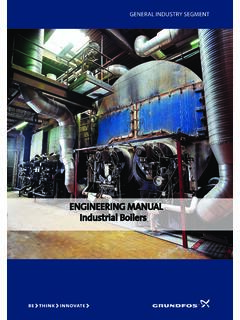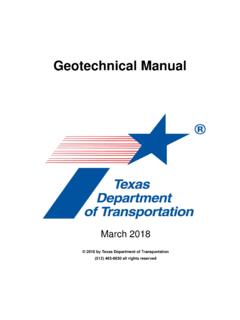Transcription of Applications Engineering Manual - Trane
1 November 2013 SYS-APM010-ENApplications Engineering ManualWater-Source and Ground-Source Heat Pump SystemsSYS-APM010-EN 2013 Trane All rights reservedWater-Source and Ground-Source Heat Pump SystemsbyJohn Murphy, Applications engineerwith Beth Bakkum, information designer 2013 Trane All rights reservedWater-Source and Ground-Source Heat Pump Systems SYS-APM010-ENPrefaceAs a leading HVAC manufacturer, we deem it our responsibility to serve the building industry by regularly disseminating information that promotes the effective application of building comfort systems. For that reason, we regularly publish educational materials, such as this one, to share information gathered from laboratory research, testing programs, and practical publication focuses on water-source heat pump (WSHP) and ground-source heat pump (GSHP) systems, including boiler/tower, ground-coupled, ground-water, and surface-water systems.
2 These systems are used to provide comfort in a wide range of building types and climates. To encourage proper design and application of a WSHP system, this guide discusses the advantages and drawbacks of the system, reviews the various components that make up the system, proposes solutions to common design challenges, explores several system variations, and discusses system-level encourage Engineering professionals who design building comfort systems to become familiar with the contents of this Manual and to use it as a reference. Architects, building owners, equipment operators, and technicians may also find this publication of interest because it addresses system layout and control. Trane , in proposing these system design and application concepts, assumes no responsibility for the performance or desirability of any resulting system design. Design of the HVAC system is the prerogative and responsibility of the Engineering and the Trane logo are trademarks of Trane in the United States and other countries.
3 All trademarks referenced in this document are the trademarks of their respective and Ground-Source Heat Pump SystemsiiiTable of ContentsPreface .. iiOverview of a Water-Source Heat Pump System .. 1 Basic System Operation .. 2 Zone is occupied and requires cooling .. 2 Zone is occupied, but requires no cooling or heating .. 3 Zone is occupied and requires heating .. 3 Zone is unoccupied .. 4 Seasonal operation of the water loop .. 5 Benefits of WSHP Systems .. 7 Provides multiple zones of comfort control .. 7 Opportunity to save energy .. 8 Limits impact of equipment failure .. 10 Ease of installation .. 10 Scalable capacity .. add it as needed .. 10 Opportunity for individual tenant metering .. 10 Drawbacks/Challenges of WSHP Systems .. 11 Equipment is located in or near the occupied spaces .. 11 Distributed maintenance .. 11 Dedicated outdoor-air system is typically required.
4 11 Common Building Types That Use WSHP Systems .. 11 Primary System Components .. 12 Water-Source Heat Pumps .. 12 Reversible, direct-expansion (DX) refrigeration circuit .. 12 Components of the DX refrigeration circuit .. 13 WSHP operation during cooling mode .. 16 WSHP operation during heating mode .. 17 Water-regulating valves .. 18 Water flow rate .. 18 Fan .. 19 Electronically commutated motor .. 20 Multiple-speed fan operation .. 21 Filters .. 22 Condensate management .. 27 WSHP configurations .. 28 AHRI/ISO rating standards .. 30 Water Distribution Loop .. 32 Water-circulating pumps .. 32 Centralized versus distributed pumping .. 32 Constant- versus variable-flow pumping .. 34ivWater-Source and Ground-Source Heat Pump Systems SYS-APM010-ENTable of ContentsPiping layout .. 36 Direct- versus reverse-return arrangement .. 36 Single-pipe system.
5 37 Pipe sizing .. 38 Pipe insulation .. 38 Isolation valves and flow-control devices .. 39 Other hydronic accessories .. 41 Heat Rejection .. 42 Cooling tower .. 42 Sizing the cooling tower .. 44 Freeze protection .. 46 Natural heat sink .. 49 Heat Addition .. 49 Hot-water boiler .. 49 Non-condensing versus condensing boilers .. 50 Sizing the boiler in a system with night setback .. 51 Sizing the boiler in a system without night setback .. 52 Hot-water storage .. 53 Low-temperature storage .. 53 High-temperature storage .. 54 Sizing the storage tank .. 55 Electric resistance heat in the WSHP ( boiler-less system) .. 57 Natural heat source .. 58 Dedicated Outdoor-Air System .. 58 Dedicated OA system configurations .. 59 Neutral- versus cold-air delivery .. 64 Exhaust-air energy recovery .. 70 Dedicated OA equipment types .. 73 Air Distribution.
6 83 Supply duct system .. 84 Supply-air diffusers .. 85 Return-air path .. 86 Controls .. 87 System Design Issues and Challenges .. 88 Thermal Zoning .. 88 Perimeter versus interior zones .. 88 Optimizing the number of zones .. 89 Locating the zone sensor .. 90 Using wireless technology .. 90 Ventilation .. 91 Zone-level ventilation requirements .. 91 System-level ventilation requirement .. 93 Dynamic reset of intake airflow .. 98 SYS-APM010-ENWater-Source and Ground-Source Heat Pump SystemsvTable of ContentsHumidity Control .. 98 Dehumidification .. 98 Dehumidification impact of compressor cycling .. 98 Full-load versus part-load dehumidification performance .. 101 Methods for improving dehumidification performance.. 103 After-hours dehumidification .. 109 Humidification .. 110 Energy Efficiency .. 111 Minimum efficiency requirements .. 111 Minimum equipment efficiencies.
7 112 Maximum allowable fan system power .. 113 Economizers .. 116 Demand-controlled ventilation .. 119 WSHP distribution loop design and control .. 120 Cooling tower control .. 121 Exhaust-air energy recovery .. 121 Auxiliary heat control .. 122 Opportunities to further reduce system energy use .. 122 Acoustics .. 125 Defining an acoustical model .. 125 Specific acoustical recommendations .. 128 WSHP: console (or unit ventilator) models .. 128 WSHP: horizontal models .. 129 WSHP: vertical units .. 131 WSHP: vertical-stack models .. 133 Cooling towers and other ancillary equipment .. 134 System Design Variations .. 135 Ground-Source Heat Pump Systems .. 135 Ground-coupled heat pump systems .. 136 Surface-water heat pump systems .. 152 Ground-water heat pump systems .. 153 Hybrid WSHP System Configurations .. 155 Water-cooled, self-contained VAV systems serving interior zones.
8 155 Water-to-water heat pump or water-cooled chiller serving AHU .. 156 System Controls .. 158 Unit-Level Control .. 160 Water-source heat pump .. 161 Zone temperature control .. 161 Economizer control .. 162 Hot-gas reheat for humidity control .. 165 Evaporator freeze protection .. 166 Safeties .. 167 Water-circulating pump(s) .. 167 Cooling tower .. 169 Closed-circuit cooling tower .. 170 Open cooling tower .. 171viWater-Source and Ground-Source Heat Pump Systems SYS-APM010-ENTable of ContentsHot-water boiler .. 172 Dedicated outdoor-air system .. 173 System-Level Control .. 174 Coordination during different operating modes .. 175 Occupied mode .. 175 Occupied standby mode .. 176 Unoccupied mode .. 176 Morning warm-up (or cool-down) mode .. 178 Scheduling .. 179 Water loop temperature control .. 180 Bypassing the ground heat exchanger .. 181 Preheat for morning warm-up.
9 183 Precool loop for morning cool-down .. 183 Safeties .. 184 Building pressure control .. 185 System optimization .. 187 Optimal start .. 187 Demand-controlled ventilation .. 188 Reset dedicated OA leaving-air temperature .. 191 Loop temperature optimization .. 193 Coordination with other building systems .. 194 Glossary .. 195 References .. 207 Index .. 211 SYS-APM010-ENWater-Source and Ground-Source Heat Pump Systems1 Overview of a Water-Source Heat Pump SystemIn a typical water-source heat pump (WSHP) system, each zone has a dedicated WSHP that cools or heats air to maintain the desired temperature in that zone. A WSHP contains all the components of a refrigeration circuit, including one or more compressors, a refrigerant-to-air heat exchanger, a refrigerant-to-water heat exchanger, and an expansion device (Figure 1). In addition, a reversing valve allows the WSHP to reverse the direction of refrigerant flow, and change the operation of the refrigeration circuit to provide either cooling or 1.
10 Components of a WSHPD epending on the style of equipment used, a WSHP may be installed along the wall within the occupied space, in the ceiling plenum above the space, in a closet or mechanical room near the space, or on the roof of the air from the zone is drawn into the WSHP through the intake (Figure 1). This air passes through a filter, refrigerant-to-air heat exchanger, and fan before it is discharged either directly into the zone or through supply ductwork and supply-air the heat pumps are connected to a common water loop (Figure 2). Also connected to this loop are a heat rejecter (such as a cooling tower, fluid cooler, or ground heat exchanger), a heat adder (such as a hot-water boiler or ground heat exchanger), and water-circulating loopconnectionsexpansion devicecompressorrefrigerant-to-water heat exchangerrefrigerant-to-air heat exchangerdrainpancondensate drain linefanreversing valvefiltercontrolbox2 Water-Source and Ground-Source Heat Pump Systems SYS-APM010-ENOverview of a Water-Source Heat Pump SystemFigure 2.




